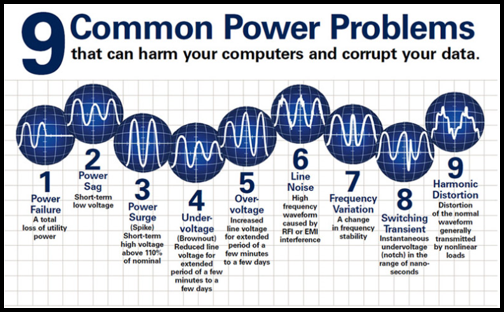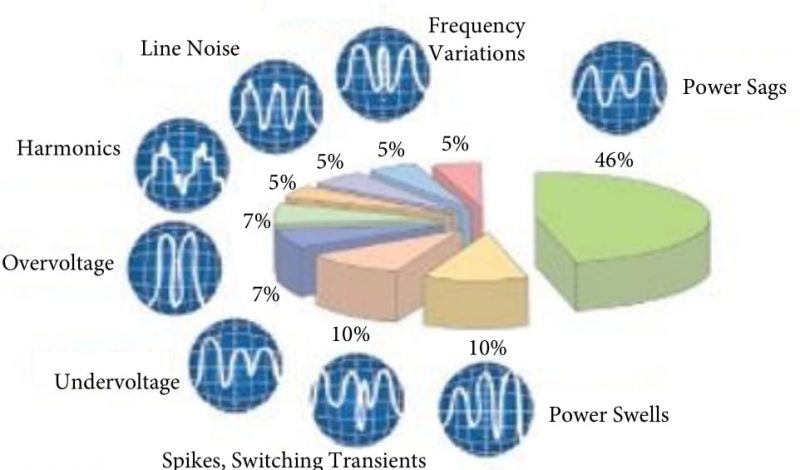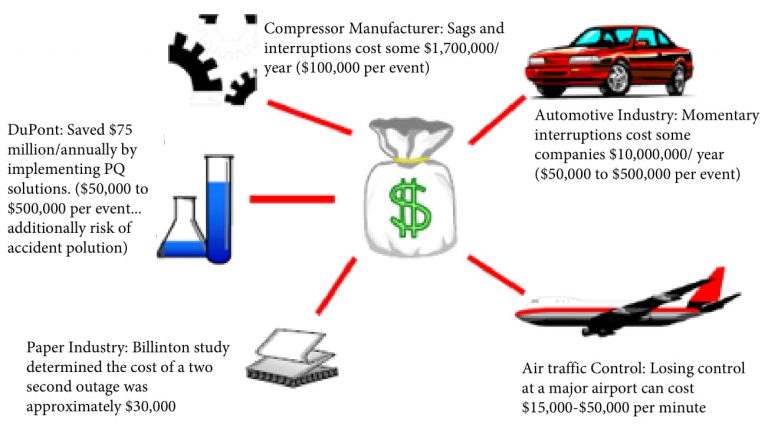Factory Power Quality
Common Power Problems Found in a Factory Setting
Percentage of Occurrence of Each Type of Power Problem


Common Power Problems
Power Failure – When your equipment experiences a total loss of power due to an unforeseen circumstance. This can cause your product to malfunction, lose of data, destroy part of your equipment or completely disable your equipment. This could also happen to multiple units at a time. These types of problems can occur when the power is completely cut to your equipment. This may also cause your equipment to restart.
Severe Voltage Sag – A manufacturing process shutdown at a large industrial manufacturing plant was caused by the failure of a company-owned 2,000 kVA transformer in another part of the plant. The failure shorted the line for five cycles before the fault recloser restored normal voltage. Although the incident was isolated, it affected the entire facility. The solution centers on supplying power to the controller throught a UPS or a motor/generator with sufficient flywheel inertia to rid through the sag.
Power Sag – When the voltage hits a point that is lower than it should be for a short period of time. This can cause great strain on your equipment as your equipment is manufactured to be operated in a certain voltage range. The power supply that is in the unit takes the most damage due to this power sag. When there is a power sag, you will typically see the lights in the building dim. This typically resets your equipment.
Power Surge – When the voltage hits a point that is higher than it should be for a short period of time. This may cause serious damage to your equipment as the voltage exceeds the maximum amount of voltage the unit can handle. You may see your lights get brighter for a moment and then the power will go out typically. This typically happens with faulty wiring from your electric company or from a lightning storm.
Under Voltage (Brownout) – When the voltage running to the equipment is lower than it should be for an extended period of time. This will put a large strain on your equipment as it is not operating in the correct voltage range. This may also cause your equipment to restart or shut off. You may experience this if a majority if not all of your equipment powers down and does not come back online for a few seconds or longer.
Over Voltage– When the voltage running to the equipment is higher than it should be for an extended period of time.This can damage any part of equipment used no part of any of your equipment is built to sustain this type of voltage for an extended period of time. If this happens, you will typically see your equipment start to overheat or shut off.
Line Noise – The disruption that can occur through the interface of stray electromagnetic signals during data transmission. The effect on your equipment is minimal but with line noise, you may have a hard time connecting with any wireless equipment. This may make it hard to get the proper work done as the convenience of wireless options may not be available.
Frequency Variation – When there is stability issues with the frequency being used. This will make your equipment operate at a higher temperature range than it should and may greatly reduce the life of the equipment affected.
Switching Transient – When there is fluctuation of under voltage in the span of nano seconds.This has similar effects to what typical under voltage would do but it is more severe as it is not a gradual decrease in voltage. It is instantaneous. This may cause your equipment to restart or shut off randomly.
Harmonic Distortion – When non-linear loads distort the normal wavelengths that are transmitted. This is caused by your current and voltage being deviated and distorted. This can greatly decrease the life of your equipment due to the total amount of fluctuation that happens as well as make your equipment operate at a higher temperature and not function at its full capabilities.
Examples of Financial Loss Due to Power Quality Problems

Failure of Variable Speed Drives – Intermittent shutdown of 5hp variable-speed drives at a manufacturing plant resulting when power factor capacitors were switched into the utility power grid without a corresponding increase in RMS voltage. Because the protective circuitry of the drive was sensitive to extremely short periods of overvoltage, an increase to 800 volts peak for as little as 40 microseconds would cause shutdown. The solution involved the installation of transient supporters at the inputs to the drives.
Rectifier Spikes – Rectifier spices disturbed control circuits at a printed circuit-board manufacturing plant with its own automated waste treatment process. Each of several treatment vats was outfitted with a single-phase, 0.5 hp, rectifier supplied, DC-motor-driven metering pump. The pumps locked up, shutting down the treatment process, or failed for no apparent reason. Investigation uncovered at 480-volt, six-pulse, phase-controlled rectifier for an electroplating cell. Because of the high source impedance of the step-up transformer, disturbance on the 480-volt line were reflected back into the 120-volt pump feed line and the pump control electronics. A separate feed for the waste treatment system was brought directly from the facility’s main service entrance to resolve the problem.
PC Software Lockups – In the final assembly and test area of a computer system hardware manufacturing operation, software for the 30 PCs controlling the test procedures locked up, shutting down the test procedures once or twice each day. Neutral-to-ground voltage disturbance were traced to an isolated grounding conductor within the transformer enclosure. The conductor had been cut, possibly to eliminate the ground lock created through the static discharge ground rods after circuit board assemblers complained about minor shocks while working on the bench. To address the lock-up problem, the ground system was unified by rebonding the isolated ground conductor to the ground buss bar in the main service entrance and reconnecting wrist straps to the same isolated ground. Neutral-to-ground impulses and computers lockouts stopped, as did shocks to operators.
Damage or Shortening the Life of Flash Memory in your Equipment – Lots of controllers in your factory installed with flash memory are very sensitive to the power problems. The power problems not only result in data loss but also permanently damage or shorten the life of your flash memories.
What are These Power Quality Issues Costing Businesses?
Industrial Impact – Industrial and Delaware firms are collectively losing $45.7 billing a year to outages. Power outages cost each of the roughly 2 million establishments in these three sectorse more than $23,000 a year. the bulk of the loss ($29.2 billion) is concentrated in the F&ES sector, which is particularly vulnerable to equipment damage. DE firms lose $13.5 billing to outages annually, primarily from lost productivity and idled labor. The greatest losses per establishment are among CPM firms, which suffer the loss of raw materials as well as the cost of incurred by other sectors